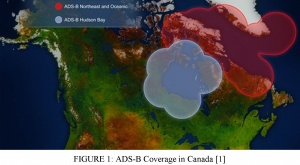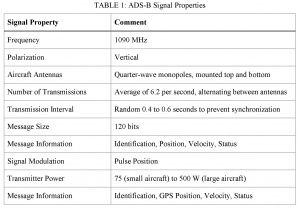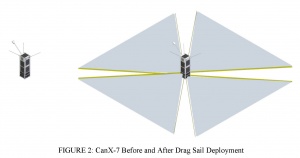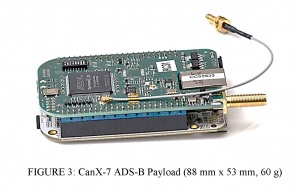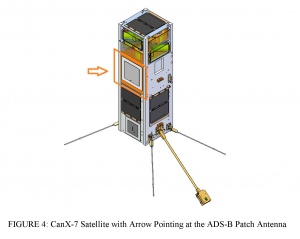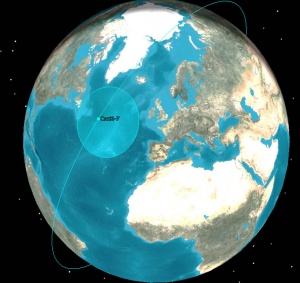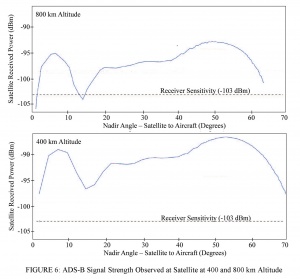CanX-7 ADS-B Mission: Tracking Aircraft from Space by Ron Vincent
From The Space Library
Ron Vincent, Royal Military College of Canada, PO Box 17000, Station Forces Kingston, Ontario Canada, K7K 7B4, Ron.Vincent@rmc.ca
Contents |
Abstract
Automatic Dependent Surveillance -Broadcast (ADS-B) is an air traffic surveillance technology in which aircraft transmit identification, position, velocity and status. The development of space based ADS-B will allow precise control of aircraft in areas that are not covered by radar or ground based ADS-B systems, such as oceanic regions and high latitudes. The Royal Military College of Canada (RMCC) has developed a space based ADS-B receiver that is scheduled to fly on the Canadian Advanced Nanospace eXperiment-7 (CanX-7) nanosatellite as a technology demonstrator in 2016. The payload will collect ADS-B data on 1090 MHz over the North Atlantic, which will then be compared to truth data provided by air traffic services. A detailed model of the 1090 MHz signal propagation has been developed at RMCC, and indicates that the power received at the satellite in low Earth orbit will be sufficient to successfully conduct the mission. Validation of the model, which could be used for the development of an operational ADS-B system, will be possible with the retrieval of data from the CanX-7 mission. Once sufficient data has been collected from the North Atlantic, ADS-B signals will be collected in higher density air traffic areas to study signal collisions. These efforts are topical with the announcements of ADS-B receivers being used as secondary payloads on the Iridium Next constellation in 2018.
1. Introduction
Automatic Dependent Surveillance -Broadcast (ADS-B) is a system in which aircraft transmit identification, GPS-derived position, velocity and status during flight. ADS-B information is transmitted in a coded message that can be received by other aircraft or Air Traffic Service (ATS) ground stations to facilitate air traffic separation. The rapid update cycle of the transmissions, combined with the use of satellite positioning, allows ADS-B to provide more accurate and timely surveillance information than conventional radars.
Ground based ADS-B is currently used in regions to provide surveillance information to ATS agencies where coverage is not available or to augment existing radar systems. Canada’s airspace authority, NAV CANADA began using ADS-B ground stations in 2009, eventually covering the Hudson Bay and Baffin Bay regions (Figure 1). The reduced aircraft separation allowed by the NAV CANADA ADS-B deployments is projected to save airliners $379 million in fuel savings and a subsequent reduction of approximately one million metric tons of greenhouse emissions by 2020 [1]. Airspace authorities in Europe, the United States, and Australia, have also implemented ADS-B as part of their ATS system.
FIGURE 1: ADS-B Coverage in Canada [1]
Worldwide coverage by terrestrial aircraft tracking systems is limited by the location of ground stations, which cannot be installed in mid-ocean and are difficult to construct in the high Arctic, leaving a critical gap in coverage for oceanic and high latitude airspace. A potential solution for global aircraft monitoring is through the implementation of ADS-B receiver on orbital platforms. Since 2009 the Royal Military College of Canada (RMCC) has actively pursued research in space based ADS-B, conducting high altitude balloon missions and publishing research in the field [2-7]. As a result of this work, RMCC has developed an ADS-B receiver that is scheduled to fly as a technology demonstrator on the Canadian Advanced Nanospace eXperiment-7 (CanX-7) nanosatellite in 2016. The CanX-7 ADS-B mission is topical in light of the proposed 66-satellite Iridium Next constellation, which will carry ADS-B receivers with a goal of global aircraft tracking by 2018 [8, 9].
The paper is organized as follows. Section 2 describes the ADS-B signal while Section 3 gives details of the CanX-7 mission. Section 4 is a description of RMCC ADS-B research and Section 5 contains a summary.
2. ADS-B Signal
The ADS-B message is a 120-bit transmission that is broadcast randomly on a period that ranges between 0.4 and 0.6 seconds to prevent aircraft from having synchronized transmissions and potentially cancelling one another out. An average of 6.2 messages per second are transmitted by each aircraft, with transmissions alternating between top and bottom quarter-wave monopole antennas. Required transmitter power for the ADS-B signal varies with the aircraft category, ranging between 75 for small aircraft and 500 W for large airliners [10]. For high performance aircraft the ADS-B information is transmitted on 1090 MHz with a pulse position modulation. As of November 2015, in preparation for space based ADS-B, the International Telecommunications Union allocated the 1087.7 to 1092.3 MHz frequency band for Earth-to-space aircraft ADS-B emissions [11]. Table1 gives a summary of the ADS-B signal.
TABLE 1: ADS-B Signal Properties
3. CanX-7 ADS-B Payload
CanX-7 is a 3U cubesat that measures 10 x 10 x 34 cm with a mass of 3.5 kg, developed built and tested by the University of Toronto Institute of Aerospace Studies (UTIAS). The primary payload is a deployable drag sail to demonstrate a method for passive spacecraft de-orbiting [12]. The drag sail mission is in response to the United Nations space debris mitigation guidelines, which requires a satellite to be actively de-orbited if the post-mission orbital lifetime is greater than 25 years. For small satellites with high ballistic coefficients and no propulsion system these guidelines may be problematic. The de-orbiting technology is a lightweight, modular, deployable drag sail providing 5 m2 of sail area following deployment (Figure 2). The secondary payload is the RMCC ADS-B receiver. Scheduled for launch in 2106 on an Indian Polar Satellite Launch Vehicle, the CanX-7 mission concept is to collect ADS-B data over the North Atlantic for six months before deploying the sail. Orbital parameters are currently unknown, but it is assumed that the orbital altitude will fall between 400 and 800 km with an inclination that will allow coverage of the North Atlantic airspace.
FIGURE 2: CanX-7 Before and After Drag Sail Deployment
The ADS-B receiver, Radarcape, is supported by a single board computer called the Beaglebone, which is an ARM Cortex A8 processor. The Beaglebone is mounted on a development board that has expansion connectors, a micro-SD card, on-chip Ethernet and a USB host port that typically runs the Angstrőm Linux distribution (Figure 3). Throughput of the ADS-B receiver is 1,700 messages per second. The time of reception and power of each ADS-B signal will be recorded as part of the mission. The ADS-B antenna is a circularly polarized patch antenna with a half-beamwidth angle of 55º with a gain of -2.35 dB at 1090 MHz. The minimum detectable signal antenna is -103 dBm with a bandwidth of approximately 4 MHz [3]. Attitude control shall be accomplished with a magnetic torquer to align the satellite with the Earth's magnetic field, necessitating the placement of the ADS-B antenna on the side of the 3U structure (Figure 4).
FIGURE 3: CanX-7 ADS-B Payload (88 mm x 53 mm, 60 g)
FIGURE 4: CanX-7 Satellite with Arrow Pointing at the ADS-B Patch Antenna
ADS-B data collection is planned to take place over the North Atlantic region in the Gander and Shanwick Oceanic Control Areas for a maximum of two minutes per orbit. Based on air traffic patterns provided by NAV CANADA it is expected that 50 to 220 hundred aircraft will be in the field-of-view of the satellite, which is approximately 2800 km in diameter from an altitude of 800 km (Figure 5), during data collection periods. ADS-B data will be stored onboard and then downlinked to the UTIAS ground station on S-band. Subsequent data analysis will take place at RMCC.
FIGURE 5: CanX-7 ADS-B Antenna Field-of-View from 800 km Altitude (AGI STK Software)
4. RMCC ADS-B Research
As part of the Space Mission Analysis and Design course, RMCC space science students were the first to put an ADS-B receiver into near space [2]. The Flying Laboratory for Observation of ADS-B Transmissions (FLOAT) -1 and -2 were high altitude balloon missions that took place in May and June 2009 respectively. Balloons were launched from Wingham, Ontario and were recovered approximately 90 km east of the launch site. FLOAT-1 experienced unresolved computer problems, but FLOAT-2 was successful. FLOAT-1 and -2 used a commercial ADS-B receiver that was updated once per minute. During the 2.4 hour flight, the payload reached an altitude of 92,850 feet (28.3 km), recording 2,076 ADS-B messages from 41 different aircraft, almost half of which were received above controlled airspace (60,000 feet). NAV CANADA verified that all ADS-B equipped aircraft were detected by FLOAT-2 within a 200 km radius of the payload while the balloon was above controlled airspace.
The success of FLOAT-2 led RMCC students to develop the Space ADS-B Receiver Experiment (SABRE). With a mission objective to demonstrate the technical feasibility of a space based ADS-B receiver system, SABRE was the RMCC entry in the Canadian Satellite Design Challenge (CSDC) in 2011. SABRE passed the critical design stage in the CSDC, and cubesat components were purchased for satellite construction. The SABRE ADS-B payload, which did not have the update restrictions of the initial FLOAT experiments, was tested on a high altitude balloon mission in 2012. FLOAT-3, carrying the proposed satellite payload, reached an altitude of 95,000 and collected over one million aircraft messages during a 2.3 hour mission. In 2013 RMCC was approached by COM DEV Ottawa to put the SABRE payload on CanX-7 as a hosted payload, at which point the plans for SABRE construction were halted.
In preparation of the CanX-7 mission a detailed model was created to determine power levels arriving at the satellite. The model takes into account neutral atmosphere and ionospheric effects, aircraft-satellite geometry and antenna radiation patterns [3]. A simulation using the model was run by inserting aircraft data provided by NAV CANADA into the model and placing the satellite at altitudes of 400 and 800 km. Results of the simulation indicate that power received at the satellite from approximately nadir to 60 degrees, ranges between -88 dBm and -103 dBm for altitudes between 400 and 800. When compared to the sensitivity of the satellite receiver, the simulation indicated that virtually all signals should be received assuming the satellite is below 800 km altitude (Figure 6). As seen in Figure 6, there is a null directly below the satellite, and a small reduction in received power 12 degrees from nadir, as a result of the radiation pattern of the aircraft quarter-wave monopole. The maximum time that an aircraft could be out of contact as a result of the null at nadir is 10 seconds.
FIGURE 6: ADS-B Signal Strength Observed at Satellite at 400 and 800 km Altitude
Further research was carried out to determine whether ADS-B transmissions would be missed during the CanX-7 mission due to signal collisions. The large field-of-view of the ADS-B antenna means that more than 200 aircraft may be detected at any one time, leading to ADS-B messages arriving simultaneously at the receiver and not being decoded. A simulation of CanX-7 passage over the operations was carried out to calculate the probability of signal collisions. In the simulation it was assumed that signals arriving at the receiver at the same time would be garbled and not decoded. In the simulation, the longest time period that an aircraft went unobserved due to signal collisions was 3.7 seconds [4]. As a point of reference, terminal control areas can have up to 15 seconds missed contact in accordance with radar standards. The probability of going 15 seconds without observing a specific aircraft transmission due to signal collisions for CanX-7 operations was determined to be 4.4 × 10-13 [4].
RMCC ADS-B research not directly related to tracking aircraft includes the determination of near surface wind speed using a multi-static scatterometry technique [5]. The power of a reflected ADS-B signal off the ocean from the lower antenna is directly proportional to the wave height. Higher waves, which are indicative of stronger winds, result in stronger reflections. There is also research involving the potential tomography of the ionosphere through the analysis of Faraday rotation of ADS-B signals traveling from aircraft to satellite [6]. Greater rotation of the magnetic field of the 1090 MHZ signal is indicative of higher ionospheric electron concentration.
5. Summary
Space based ADS-B is a technology that will allow worldwide monitoring of air traffic. The CanX-7 nanosatellite, scheduled for launch in 2016, will host an RMCC payload that will monitor aircraft ADS-B transmissions over the North Atlantic. The data retrieved from the mission will allow verification of a signal propagation model, while allowing the determination of missed signals, both of which could provide valuable information for an operational constellation. The CanX-7 ADS-B data may also aid ground breaking research in multi-static scatterometry and ionospheric tomography using ADS-B signals.
References
[1] NAV CANADA, “NAV CANADA Expands Surveillance by 1.3 Million Square Kilometres,” NAV CANADA News Release, http://www.navcanada.ca/EN/media/Pages/news¬releases-2012-nr15.aspx , 2012.
[2] R. Francis, R. Vincent, J.M. Noël, P. Tremblay, D. Desjardins, A. Cushley and M. Wallace, “The Flying Laboratory for the Observation of ADS-B Signals”, International Journal of Navigation and Observation, Volume 2011, Article ID 973656, 5 pages, 2011.
[3] R. Van Der Pryt and R. Vincent, “A Simulation of the Reception of Automatic Dependent Surveillance -Broadcast (ADS-B) Signals in Low Earth Orbit”, International Journal of Navigation and Observation, 2015.
[4] R. Van Der Pryt and R.Vincent, A Simulation of Signal Collisions over the North Atlantic for a Spaceborne ADS-B using Aloha Protocol, Positioning, 2015.
[5] R. Van Der Pryt and R. Vincent, 2015, “A Model for Estimating Surface Wind Speed Using Spaceborne Automatic Dependent Surveillance -Broadcast Signals”, Under review.
[6] A. Cushley and J.M Noël, “Ionospheric tomography using ADS-B signals”, Radio Science, Volume 49, Issue 7, pp. 549–563, 2014.
[7] R. Francis, J. Noël and R. Vincent, “Orbital monitoring of automatic dependent surveillance ¬broadcast (ADS-B) signals for improved air traffic surveillance in remote and oceanic airspace,” Proceedings of the 62nd International Astronautical Congress, University of Western Ontario, Cape Town, South Africa, 2011.
[8] O.P. Gupta, “Global augmentation of ADS-B using Iridium NEXT hosted payloads”, Proceedings Integrated Communications, Navigation and Surveillance Conference, pp. 1–15, 2011.
[9] Aireon, ‘Global Air Traffic Surveillance’, http://aireon.com/services/global-air-traffic¬surveillance/ , Accessed Nov 2015.
[10] RTCA DO-260B, “Minimum Operational Performance Standards for 1090 MHz Extended Squitter Automatic Dependent Surveillance -Broadcast (ADS-B) and Traffic Information Services -Broadcast (TIS-B)”, Radio Technical Commission for Aeronautics, 2009.
[11] International Telecommunications Union, “Radio Spectrum Allocated for Global Flight Tracking,” ITU Press Release, http://www.itu.int/net/pressoffice/press_releases/2015/51.aspx , 2015
[12] G. Bonin, J. Hiemstra, T. Sears and R. E. Zee, “The CanX-7 Drag Sail Demonstration Mission: Enabling Environmental Stewardship for Nano-and Microsatellites”, Proceedings of the AIAA/USU Conference on Small Satellites, Technical Session XI: Around the Corner, SSC13-XI-9, 2013.
